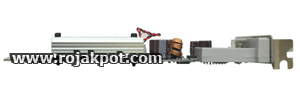The ASUS Extreme N7300GS
If you read our NVIDIA GeForce 7300 GS Tech Report, you will find the design of the ASUS Extreme N7300GS familiar. Yes, it's based on NVIDIA's P381 low-profile reference design for the GeForce 7300 GS.
Because of the PCB's low profile, ASUS had to attach the 15-pin VGA-out port to the card using a cable. Of course, they had the foresight to tack on a gray box to cover the unsightly cable.
The card used the same cooler design used in the NVIDIA reference design. It consists of a low-profile aluminium heatsink with really tiny fins and a fan with a power output of about 2W.
All four memory chips are placed at the end of the card, on both sides of the PCB. Like the NVIDIA reference design, the Extreme N7300GS used DDR2 memory chips from Infineon.
The top and bottom views of the card shows you just how thin the cooler is. You can also see the gray box that covers the connection between the VGA-out port and the PCB.
Specifications
Here are the specifications of the ASUS Extreme N7300GS. Please note that these are for the 128MB model. The 256MB model features a much slower memory clock, in addition to the larger memory buffer.
Manufacturing Process |
• 0.09 Micron |
Transistor Count |
• 112 Million |
DirectX Support |
• 9.0c |
Interface |
• PCI Express |
Vertex Pipelines |
• 3 |
Vertex Shader Version |
• 3.0 |
Pixel / Texture Pipelines |
• 4 x 1 |
Pixel Shader Version |
• 3.0 |
Core Speed |
• 550 MHz |
Fill Rate |
• 2200 MTexels/s |
Memory Bus Width |
• 64-bits |
Memory Size |
• 128 MB |
Memory Type |
• DDR2 |
Memory Speed |
• 405 MHz (810 MHz DDR) |
Memory Bandwidth |
• 6.48 GB/s |
Now, let's take a closer look at the card.
<<< Introduction, The Package : Previous Page | Next Page : GPU Cooler, The Memory Chips, External Connectors >>>







 Add to Reddit
Add to Reddit




